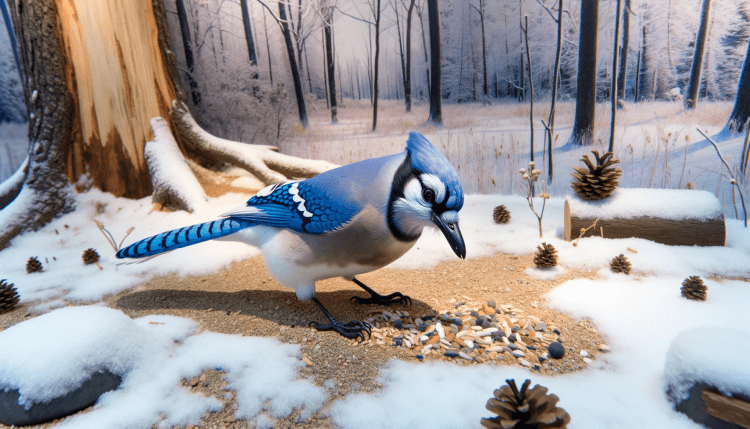
Quick Identification Guide for the Blue Jay (Cyanocitta cristata):
Appearance:
- Size: About 10 to 12 inches in length.
- Coloration: Bright blue above with a white face and underparts. Black collar around the neck and head. The wings and tail are bright blue with black bars and white spots.
- Crest: A distinctive blue crest on the head, which can be raised or lowered.
Behaviors:
- Often seen in pairs or small groups.
- Known for their loud, harsh calls and a variety of other vocalizations.
- Forages both on the ground and in trees, primarily eating nuts, seeds, and insects.
Song:
- Varied but includes clear whistled notes and jay calls.
Habitat:
- Found throughout the eastern and central United States and southern Canada.
- Common in mixed woodlands, parks, and suburban gardens.
Birds Commonly Confused With:
- Steller’s Jay: Similar in size but has a black head and body with blue wings and tail.
- Scrub-Jay: Lacks the crest and has more uniform blue and gray coloring.
- Eastern Bluebird: Smaller and primarily blue with a rusty chest, lacking the white underparts and crest.
Seasonal Behavior:
- Partially migratory, with northern populations moving south in winter. However, many are year-round residents in their range.
- More likely to visit feeders in winter, especially in areas where natural food sources are scarce.
The Blue Jay is a distinctive and charismatic bird, easily recognized by its bright blue coloring, loud calls, and crest. Their adaptability to different environments, including urban areas, makes them a familiar sight across their range.

Quick Facts About the Blue Jay (Cyanocitta cristata):
Family: Corvidae (the crow family).
Size: Typically about 10 to 12 inches long.
Coloration:
- Bright blue on the upper parts and white or light gray on the underparts.
- Distinctive black collar around the neck and head, and a blue crest on the head.
Diet: Omnivorous, feeding on nuts, seeds, fruits, insects, and occasionally small vertebrates.
Habitat: Common in a variety of habitats including mixed woodlands, parks, and suburban areas across the eastern and central United States and southern Canada.
Nesting: Nests are built high in trees, often in conifers. The nest is cup-shaped, constructed with twigs, grass, and bark.
Eggs: Typically lays 4-5 eggs, which are bluish or light brown with speckles.
Behavior: Known for their intelligence, complex social systems, and loud, varied calls. Can mimic the calls of other species, including hawks.
Migration: Partially migratory, depending on the geographic location. Northern populations may migrate southward in winter.
Cultural Significance: A popular bird in folklore and culture, often associated with curiosity and intelligence.
Conservation Status: Listed as of ‘Least Concern’ by the IUCN, with a stable and widespread population.
These facts provide a concise overview of the Blue Jay, highlighting key aspects of its biology, behavior, and role in the ecosystem and culture. The Blue Jay is one of the most recognizable and well-known birds in its range due to its distinctive appearance and vocalizations.




